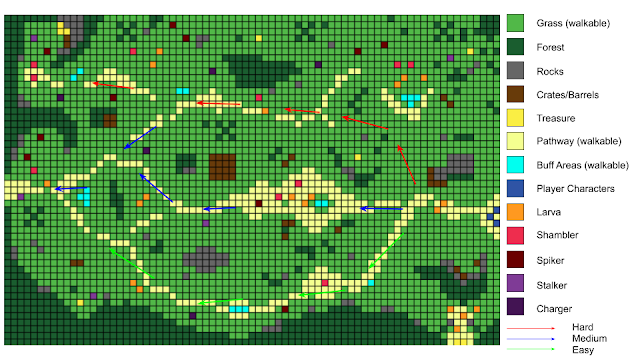Parasitic Level Design Post#2
The second sprint was focused on transitioning from conception to proofing, meaning we would be moving from designing to implementation. The cards assigned to me this sprint are:
- "As a level designer, I need to make an asset list full of possible assets needed to fill my level with purpose and theme for the shrubbery-filled meadow level."
- "As a level designer, I need to annotate an open-spaced basic introductory level that puts my newly found skills to work in a stress free environment."
- "As a level designer, I need to block out an open-spaced basic introductory level that puts my newly found skills to work in a stress free environment"
- "As a level designer, I need to populate my level with current assets to get the tone of the level established."
There was also the "As a level designer, I need to create a testing ground where we can test the most up to date mechanics" from Sprint 1 that was assigned but wasn't moved. Luckily, we finished it pretty early on for this sprint since this card just entails the Unity collab we would need to set up to implement and test our levels with.
The first Sprint 2 card I work on was the asset list card. I decided to do this first so I would know what assets I'll need in my level. This would also help me annotate my level's map since I'd know what all the core assets would be. There weren't any problems with this card, but there was a bit of feedback about one asset, which is the elevation/terrain asset; instead of requesting this as an asset, it would be better to use the terrain editor in Unity to make elevation instead.
The next card I worked on was the annotated map. We had been working on several versions of a map for our levels since the last sprint so for this sprint, it was time to fully polish up an annotated map and use it as a building guide for when blocking out our levels. I did encounter some problems with this card, mostly due to the size of the map in that it might be too big and how the level should play out.
The problem with this map was that it was still too large and that there shouldn't be multiple exits. After taking this into consideration, I went back into Photoshop to resize the grid and repaint the paths.
This is the final approved version of my map. And the next step would be blocking it out in Unity.
Blocking took a while and this is because of 1) the size of my map and 2) I would need to check off the unmovable spaces individually. I had to go at a slower pace to avoid eye strain since I would need constantly to zoom in and out while also looking back and forth between the Unity scene and annotated map.
After this was done, I could move on to actually blocking out the scene. And similarly, it took a while too since this wasn't just a choice between green and red dots but adding in different primitives as a way to keep track of what would be a tree and what was a rock. Luckily, I only needed to add six different kinds: cylinders for trees, squares for rocks, squashed cylinders for crates and barrels, spheres for buff spots, tilted squares for treasure, and of course, a capsule for the player.
Midway through this card, there was still time left in the sprint so we were also assigned the asset implementation card. However, I didn't get to finish this card before Sprint 2 ended so this is the card I have in progress for now and for the beginning of Sprint 3. I have the level mostly populated, the only thing left is terrain building and pathing.
For Sprint 3, I'll be finishing up the terrain and finally playtesting the level. I'm pretty satisified with the current state of my level and can't wait to see how everyone else's levels turn out. Cheers!












